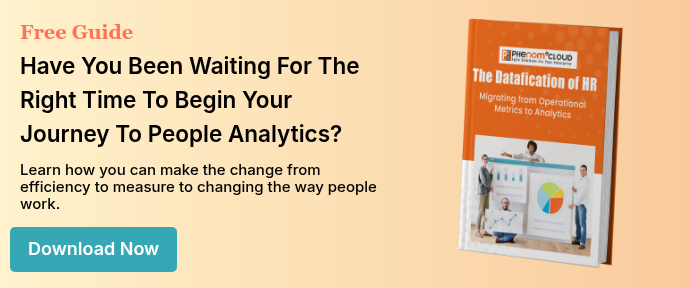
After years of nagging from industry gurus and human capital soothsayers about people analytics, there isn’t much progress. The best news we can find is that the percentage of companies capable of developing predictive models doubled to 8 percent during the past year.[1]
In our minds, that leaves a 92% gap. Finance has been using predictive modeling for decades, and we can market to specific individuals in markets of millions of people. HR has been slow to catch on.
It seems not a day goes by we don’t see an article, white paper, or infographic about people analytics. The authors often cajole CXOs to listen to HR to understand how to maximize workforce productivity.
There is a problem with that advice -- they are not listening. HR doesn’t speak their language, and they don’t trust HR data. According to a 2014 CEB Global study, [2]
- 17% of business leaders believe HR analytics focus on the right business questions, and only 18% of them trust talent data and insights from HR,
- less than 20% of business leaders believe HR staff understands the business, and
- most senior HR leaders (80%) believe staff limitations are a barrier to improving HR analytics.
We are not surprised. After years of spending billions on employee engagement without seeing a return on investment, business leaders have tired of the chase and are now focusing on redesigning the organization.[3] Now is a critical time for HR.
We can describe HR’s challenge in the words of renowned author Stephen R. Covey:
“Seek first to understand, then to be understood.”
True progress will begin when HR understands the business and speaks the language.
Learn the Language
We advise HR leaders to stop trying to get CXOs to understand HR and people. Instead, learn every facet of the business, beginning with the language: Finance and Accounting. If you are new to accounting or need a refresher, there are excellent books and online courses on finance for non-financial managers. Many of the courses are free.
Once you know the language, you can begin conversations with business leaders in their terms.
Understand the Business
In our 25 years as practitioners and consultants, we have seen many HR leaders who take a passive approach to learning the business. They try to pick it up as they go along from the conversations they have with the people. We advocate an active approach.
- Seek the people who do your strategic planning. Understand your company’s market position, its competitive pressures, and its strategy for dealing with market forces. Ask about the constraints in the industry and how the business plan deals with them. Talk with Marketing about how they position your company in the market and why. Remember to leave HR jargon inside HR. Speak Finance.
- Study financial reports and key performance indicators. Understand KPI trends and why they occur.
- Talk with functional leaders about how they operate and what their challenges are. Draw them out to learn what keeps them awake at night.
- Engage the functional leaders in conversations about organization performance. You will eventually uncover performance issues you can influence.
- When you discover a problem, offer to study it to learn where you might help. Offer to partner with them to help resolve their performance issues.
- Work with your functional leaders one at a time to use analytics to isolate a performance issue, develop an intervention, and predict and measure the outcome.
- Your partner may only be interested in financial results, but that doesn’t mean you can’t also measure people outcomes and quantify them in accounting language. That quantification will start conversations about people analytics when you include them in your success story.
Over time, the gulf between business analytics and people analytics will disappear. It won’t happen overnight, but by speaking the language of business, you can start the conversation today.
[1] “People Analytics: Gaining Speed." Human Capital Trends 2016. Deloitte United States. 2016.
[2] "HR Data Is Not Leading to Insights or Impact." CEB Global. July 31, 2014. .
[3] “The new organization: Different by design." Human Capital Trends 2016. Deloitte United States. 2016.
PhenomᵉCloud is a comprehensive technology solutions provider committed to empowering businesses to overcome challenges, enhance their workforce capabilities, and achieve superior outcomes.



Leave a Comment